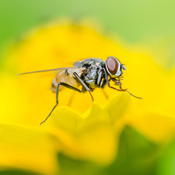Lesser house fly biology

Lesser house fly, “Fannia canicularis”
Lesser house flies have a characteristic short and erratic fly pattern. It can be seen resting on vertical surfaces. This fly species is considerably smaller (~5 mm long) than the common house fly. They have a grey thorax and a yellow banded abdomen.
Egg laying is preferred in liquid media and eggs are especially adapted to cope with a liquid environment. Eggs are deposited in around 6 batches of 50. It will take approximately 2 days for larvae to emerge. 3 distinct larval stages are present. Larva are brown and have appendages on each segment, again to cope with a semi-liquid medium. Larvae will migrate to drier area at the final stage, before pupating. It is difficult to observe this migration, as larvae and pupae have the same colour.
Adult flies emerge from a puparium in less than 2 weeks. Animal housing units are preferred breeding sites. The Lesser house fly is less of a health hygiene concern in light of disease transmission compared to the common house fly. This is probably because of a more restricted distribution and they are less attracted to foods destined for human consumption.
